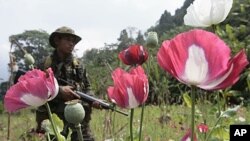The United Nations Office on Drugs and Crime (UNODC) said Thursday the land area used for opium cultivation in Southeast Asia grew by an estimated 16 percent in 2011, as farmers in Burma and Laos seek to cash in on high prices.
The UNODC says Burma, the world’s second largest producer after Afghanistan, accounted for most of the increased planting and 96 percent of the region’s opium. It produced an estimated 610 metric tons this year, about ten percent of global opium, while Laos produced 25 tons.
Southeast Asia's total production was valued at about $319 million, some $275 million of which was made in Burma. By comparison, anti-narcotics agency says Afghanistan's opium production this year is worth $1.4 billion.
UNODC representative for the Asia Pacific, Gary Lewis, spoke at the release of its annual survey on opium. He told the Foreign Correspondents Club of Thailand that most of the opium was in Shan state in northern Burma, also known as Myanmar.
"According to our estimates, what is driving the poppy increase is food insecurity, poverty, the conflict that’s raging in that part of Myanmar, and the high prices that are available for people who wish to cultivate," he said.
The UNODC says opium prices in Burma since 2010 shot from $300 to $450 per kilogram with the lowering value of the currency, the kyat, and demands from neighboring countries.
Opium prices in Laos and Thailand were higher, at $1,600 and $1,400 per kilogram respectively.
UNODC’s Burma manager Jason Eligh says poor farmers that plant the crop or work as laborers on poppy farms can earn several times the average income of other agricultural workers.
"So, you can see that it’s a rational economic choice for people who are facing these threats to their household to try and become engaged in poppy cultivation either through growing crops or through assisting in the growing and harvesting of these crops as laborers," he said.
Under eradication and crop substitute programs, Southeast Asia's major opium producers -- Burma, Laos and Thailand -- saw cultivation drop by 83 percent from 1998 to 2006.
But, since then, production has gradually increased in Burma and Laos.
Thailand is the only country in the region that has managed to keep opium production down, with the size of poppy fields dropping this year by a quarter and production down to three metric tons.
The UNODC credits Thailand’s efforts to address the problem, including crop substitution programs.
The anti-narcotic agency says more international funding is needed in Burma and Laos to introduce alternative crops and development programs that are sorely lacking.
UN: Burmese, Laotian Opium Cultivation Surging










